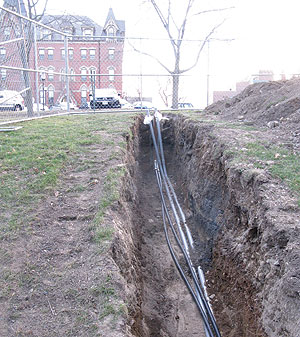
Professor Grant Garven’s innovative research into geothermal energy is catching on in a big way at Tufts University.
By Chris Leo Palermino
Soon, Tufts University may be powered by a new energy source: geothermal energy from groundwater beneath the urban campus.
Tufts geology professor Grant Garven began the project as a teaching tool for his upper-level course on hydrogeology, in which he drilled an observation well next to the geology building to demonstrate the basics of drilling wells for scientific research.
“It was to provide an outdoor laboratory, and to take advantage of the unique geology of Tufts’ campus. The geology is very interesting, as we’re sitting on top of a drumlin, which is a type of hill,” Garven said.
In the midst of drilling the well with heavy machinery on campus, the university facilities staff became interested in his work. After the university realized the environmental impact of this new energy source, which creates energy without emitting greenhouse gases, Garven received funding to continue the project.
“I did it out of curiosity, but I think that the university views it as a prototype. In a practical sense, [the geology building] is not the type of building you would want to invest in geothermal heat. But, we had a well out front, only 80 feet from the building… we’re being very modest and essentially heating and cooling one of our classrooms,” Garven said.
With the help of the facilities staff, Garven implemented a geothermal heat pump in this well. The pump removes heat from the groundwater, which remains a constant 50-to-55 degrees regardless of season, and moves it inside of a building.
“Think of [geothermal pumps] like a refrigerator, which takes heat out of food and transfers it outside of the refrigerator. Instead of food as the energy source, the pump removes heat from the ground,” Garven said.
In this specific case, the pump circulates refrigerant through the pipes that are attached to the pump on one end and an apparatus that acts like a furnace on the other end. In the winter, the pump absorbs heat from the groundwater and circulates the heated refrigerant into the building. The opposite happens in the summer, in which thermal energy from the classrooms are instead transferred through the pipes to the ground for a cooling effect.
While Garven’s motivation for the project was simply to give his students firsthand experience in the field, representatives at Tufts are considering using this technology to regulate the temperature of other buildings at Tufts.
“The [administration] had a lot of interest. These systems are everywhere. Tufts president [Anthony Monaco] is very interested in sustainability, and he has a committee organized now to assess how these systems might work at Tufts,” Garven said.
The technology, in which over 160 colleges and universities either have the system in place or are in the process of installing one according to the National Wildlife Federation in a 2011 report, offers a cost efficient, sustainable energy alternative to coal and fossil fuels.
“If you do the geology right, this is technology that can be done anywhere. But, the upfront cost is expensive…to recover the cost, it would take decades,” Garven concluded.
For a university, which relies on large amounts of energy day in and day out and will stay in the same location for decades, geothermal energy may just be the solution.












Reader Comments